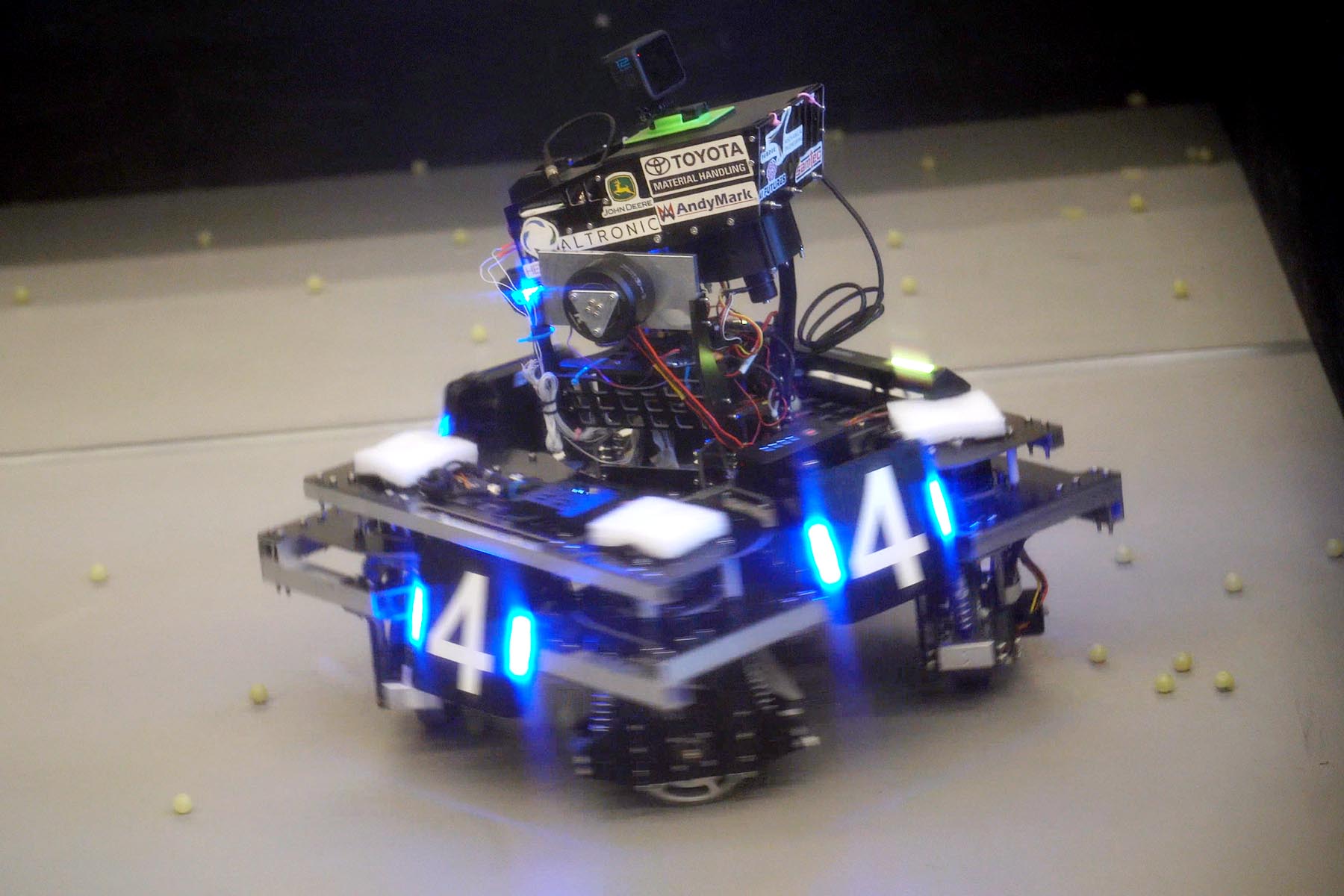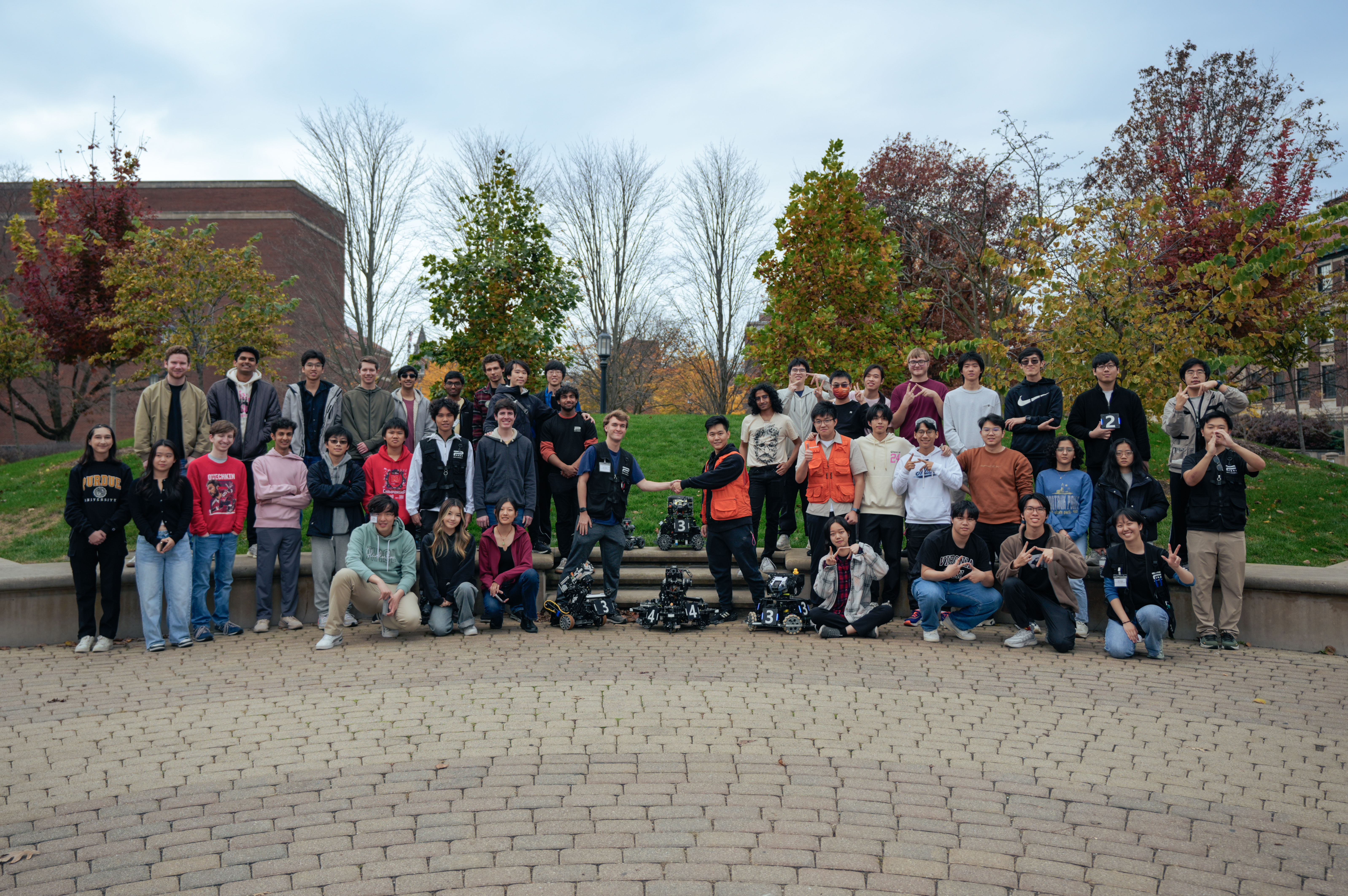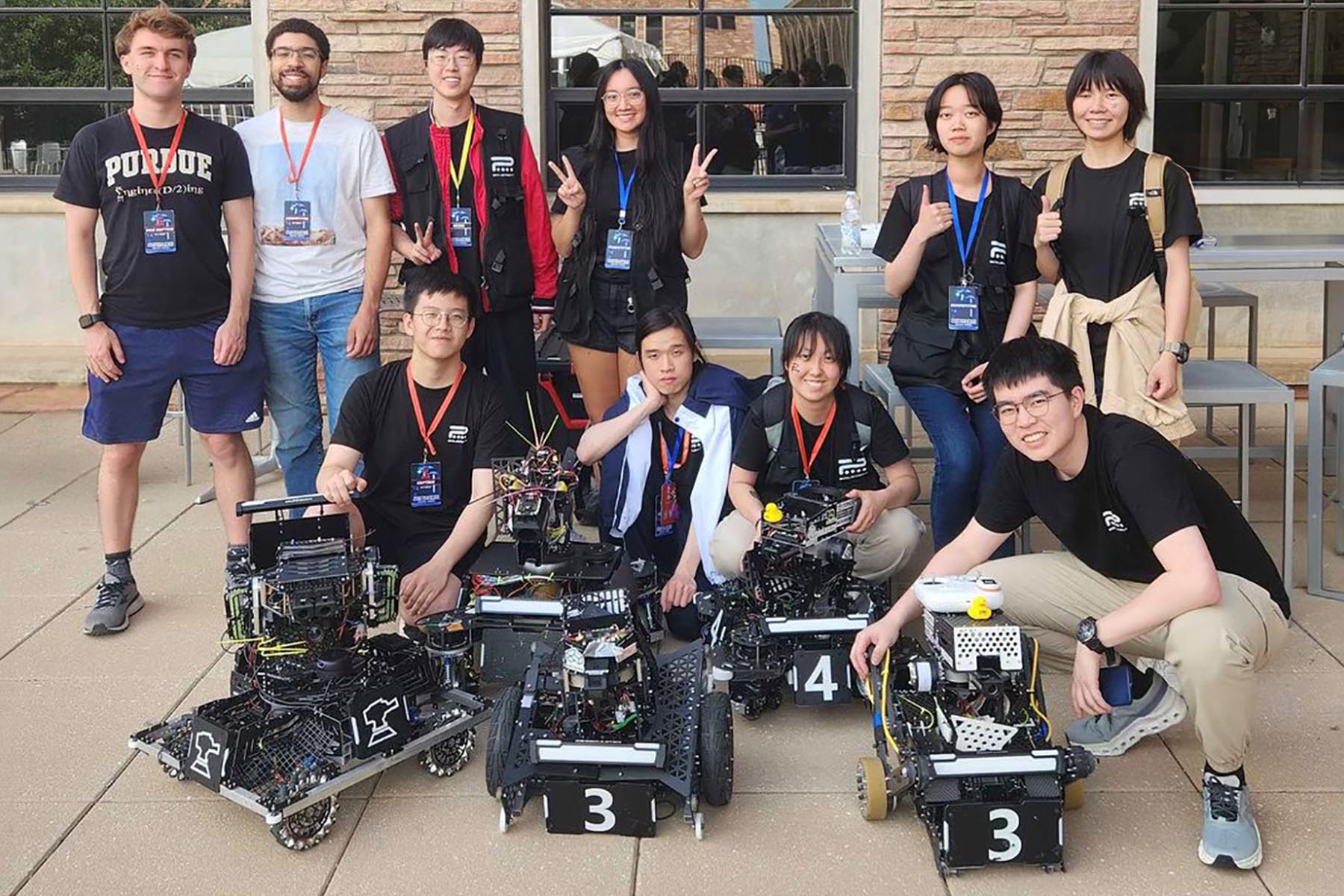RoboMaster: video games brought to life
RoboMaster: video games brought to life
Imagine a first-person shooter video game, but brought to life in an actual arena with projectile-launching robots built by students. That’s the idea behind RoboMaster, a collegiate robotics competition being hosted by the RoboMaster Club on Saturday, April 5 at Purdue.
Many people compare the competition to robot laser tag. “There’s a red robot and a blue robot in an arena with obstacles, and each robot shoots little plastic projectiles, aiming for armored plates on the opposing robot. Once their hit points are out, that robot ‘dies’ and the shooter wins” said Megan Earp, a junior in electrical engineering and the former outreach lead for BoilerBot, Purdue’s RoboMaster team.
Pilots control their robots through a laptop interface that looks like a video game, right down to the live first-person camera view and the killscreen at the end. The difference in the real world is the racket of plastic pellets ricocheting off the walls and protective arena netting.
The RoboMaster Club’s Midwest Conference is taking place on April 5 and 6, 2025 in the Stewart Center, and all are welcome to attend. The two-day conference will include seven teams: Penn State, Virginia Tech, Washington University, University of Wisconsin-Madison, Rose-Hulman, University of Colorado Boulder, and Purdue’s team BoilerBot.
This Midwest competition was created in 2023 with the goal of giving teams the chance to practice before the national competition in the summer.
“We want Purdue to be the center for robotics in the Midwest,” said Tom O’Donnell, senior in electrical and computer engineering and president of the club. “The conference not only gives other teams the chance to test their robots, but it gives everyone the chance to build connections, exchange ideas, and meet with industry.”
The second day of the conference includes technical presentations where each team is allowed to discuss what innovations they’ve made in designing their robots.
“We want people to share knowledge within the community and give people a platform to talk about their innovations and highlight each member’s impact,” said O’Donnell.
After the technical presentations, industry sponsors present their company and network with the teams.
It takes a village
Bringing this video game to life takes a lot more than just a Steam subscription. Each robot is custom-built by students over the course of a year.
"We usually have around 100 students join per year,” said O’Donnell. “And we don’t require any previous experience.”

The club has three robots they use in competition: the standard, the hero and the sentry. The standard is human operated, has two or four wheels, and launches 17-millimeter plastic projectiles. Similar to the standard, the hero is also human operated but launches much larger 42-millimeter projectiles. The last of the robots, the sentry, is fully autonomous. Everything from driving around the map to launching the projectiles is done without human control.
The club has five sub teams: Algorithm, Mechanical, Electrical, Control, and Business. Each team plays a crucial role in preparing the three robots for competition.
The Algorithm team creates the software for the autonomous robot working to make sure the robot can drive around the field and launch projectiles on its own. The software can also detect where other robots are and automatically aim at them.
The Mechanical team oversees the computer aided design (CAD) for the robot but also focuses on the manufacturing and assembly of the robot. They usually work on two to four robots a year.
The Electrical team works on the wiring and power systems in the robots. They use a super capacitor allowing the robot to store energy so that it can use it in bursts throughout the competition.
The Control team works on the mobility of the robot. One of the robots only has two wheels, so the team works to allow the robot to balance successfully. They also work on some of the software.
Finally, the Business team plans events, works on student outreach, builds relationships with industry partners and does media related tasks.
Playing by the rules
Another vital role is adhering to the rulebook; these may be plastic pellets, but safety and fairness are still vital to the competition. “The basic dimensions are regulated to be no more than 600 by 600 by 500 millimeters,” said Ruoyi Li, mechanical lead for the team. “Outside of that, we can do pretty much anything we want. But we won’t build anything too crazy — our final goal is to win the game!”
Beyond the robustness of the robots, there are also several strategies on the playfield. A four-wheeled robot is required to have four armor plates, but they don’t have to remain static. So teams will rotate the base of their robot like a whirling dervish — giving their opponents a more difficult moving target — while keeping their own shooting head stationary to better aim their own projectiles.

At least that’s the theory. In practice, sometimes the whirling prevents the robot from moving reliably around obstacles. Or the central shooter malfunctions, leaving the robot a sitting duck for the opponent. Or the camera or radio signals are disrupted, disqualifying the robot from competing. So frantic engineers are always making repairs during a competition.
“I’m a results-driven person,” jokes Li. “I spent months of my life building this robot, I want to see it win. Every competition is a chance for improvement.”
Best of the best
In order to be the best, you have beat the best. And when it comes to RoboMaster, that’s impossible to do over Zoom — you have to meet up in person.
“We’re the only university in the country that hosts something like this,” Earp said. “It’s really nice to meet other students who are on the same journey as we are!”

Of course, a robot competition in a meeting room is one thing. RoboMaster North America steps up the intensity by organizing an annual 3v3 competition to crown the North American champion.
“At our event, we compete with ‘standard’ robots,” said Jayson Stansbury, a mechanical engineering student. “In the 3v3 competitions, they add two more classes of robot: the ‘hero,’ and the ‘sentry.’ Those contests can get pretty hectic!”
Last year’s North American competition took place in Boulder, Colorado in June 2024, where Purdue BoilerBot finished 5th out of 26 teams. “This is an impressive result,” Earp said, “but more importantly we all had fun and shared some great memories. We achieved large technical advances in all areas of development and operations, thanks to the support of our sponsors and our amazing team members. We can’t wait for the thrilling season ahead!”
“I think RoboMaster is the best arena for the best engineers,” said Jia Xie, a mechanical engineering student who serves as project manager for BoilerBot. “It’s a complex project that not only requires multidisciplinary engineering skills, but great communication and professional practice skills. I love it when all these people are working together towards a single goal.”

The Midwest Robomaster competition is taking place on April 5 at 10:30am and April 6 at 8:00am in the Stewart Center Room 214, and all are welcome to attend both days for free! If you have questions email the RoboMaster club at rmc@purdue.edu.
